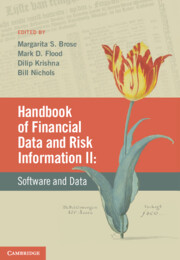Book contents
- Frontmatter
- Contents
- List of contributors
- Preface
- VOLUME II: SOFTWARE AND DATA
- PART IV DATA OPERATIONS IN FINANCIAL INSTITUTIONS
- PART V DATA MANAGEMENT TECHNOLOGIES
- PART VI IMPLEMENTATION OF DATA AND ANALYTICS PROGRAMS
- 25 Project implementation
- 26 Operations management
- 27 Data governance and data stewardship
- Index – Volume II
- References
25 - Project implementation
from PART VI - IMPLEMENTATION OF DATA AND ANALYTICS PROGRAMS
- Frontmatter
- Contents
- List of contributors
- Preface
- VOLUME II: SOFTWARE AND DATA
- PART IV DATA OPERATIONS IN FINANCIAL INSTITUTIONS
- PART V DATA MANAGEMENT TECHNOLOGIES
- PART VI IMPLEMENTATION OF DATA AND ANALYTICS PROGRAMS
- 25 Project implementation
- 26 Operations management
- 27 Data governance and data stewardship
- Index – Volume II
- References
Summary
Introduction
Project management is the bedrock for any successful system or process implementation. The practice and development of techniques for effective project management – especially in Information Technology (IT) projects – has come a long way in the past few decades. Best practices and IT management folklore popularized in seminal works like The Mythical Man-Month (Brooks, 1997) have been transformed into standardized, teachable techniques by large consulting firms as well as industry organizations like the Project Management Institute. Many believe that implementation of these techniques has vastly improved the quality and timeliness of IT projects. Yet large IT projects still continue to offer up huge challenges in their implementations.
The challenges of project management are perhaps most evident in the implementations of large risk management, finance transformation and regulatory projects in financial institutions. For example, some estimates put the cost of Basel II compliance spending at as much as 10% of banks' overall IT costs (VanHoose, 2007). Certainly the largest banks in the USA, Europe and Canada have each consumed hundreds of millions of dollars on Basel II compliance. These have not all been entirely happy experiences. While typical large project management techniques have been employed in these firms, the often similar challenges experienced and worked through by project teams suggests that these projects are unique in nature, and different from traditional large application development and implementation projects.
- Type
- Chapter
- Information
- Handbook of Financial Data and Risk Information IISoftware and Data, pp. 387 - 432Publisher: Cambridge University PressPrint publication year: 2014



